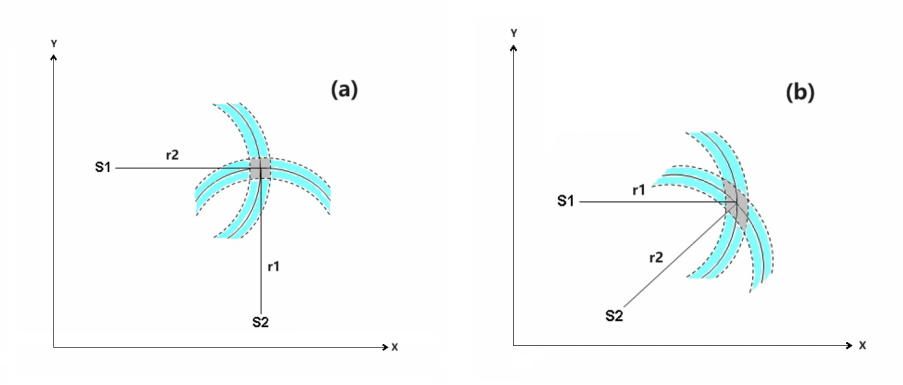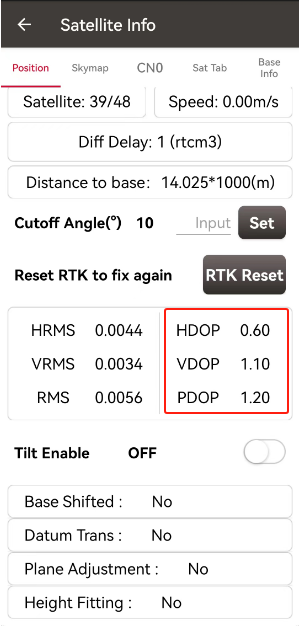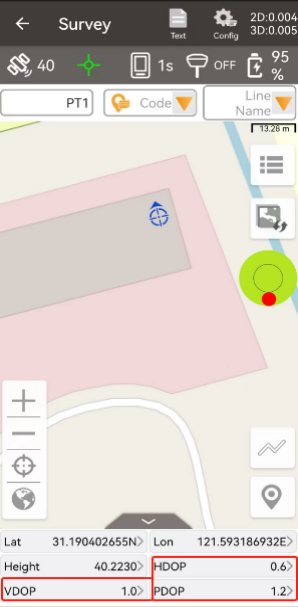What is DOP in GNSS?
Mila Tao, Tersus GNSS 12 Jan, 2024
To achieve high-precision positioning, it is essential to consider not only the accuracy of the satellite system itself but also the impact of factors such as the DOP values.
Definition
DOP, which stands for Dilution of Precision, is a metric that assesses the impact of the geometric distribution of visible satellites in a navigation system on the accuracy of positioning. It evaluates the reliability of a receiver's position by considering the geometric arrangement of satellites in the sky. When navigation satellites are closely positioned in the sky, the geometric configuration is weaker, resulting in a higher DOP value. Conversely, when satellites are positioned farther apart, the geometric configuration is stronger, leading to a lower DOP value.
A simple example
The blue shaded area represents the measurement error of two satellite signals, while the gray shaded area represents the uncertain region of the receiver's position.

In Figure a: S1(Satellite 1) is positioned orthogonal to S2, so the receiver can determine x and y coordinates with the same accuracy, resulting in a small area of position uncertainty (low DOP value). In Figure b: S2 is closer to S1, leading to a significantly larger area of position uncertainty (high DOP value), with the confidence in the Y coordinate being smaller than the X coordinate. We consider the accuracy in case b is diluted in comparison to that of case a.
Therefore, a low DOP value represents better position accuracy.
Different meanings represented by DOP values
| DOP value | Rating | Description |
| <1 | Ideal | Highest possible confidence level to be used for applications demanding the highest possible precision at all times. |
| 1~2 | Excellent | Excellent Positional measurements are considered accurate enough to meet all but the most sensitive applications. |
| 2~5 | Good | Positional measurements could be used to make reliable in-route navigation suggestions to the user. |
| 5~10 | Moderate | Positional measurements could be used for calculations, but the fix quality could still be improved. A more open view of the sky is recommended. |
| 10~20 | Fair | Positional measurements should be discarded or used only to indicate a very rough estimate of the current location. |
| >20 | Poor | Measurements are inaccurate by as much as 300 meters with a 6-meter accurate device (50 DOP×6 meters) and should be discarded. |
Several DOP measurements with different definitions
◆ HDOP: Horizontal Dilution of Precision, measures how the geometric distribution of satellites affects the accuracy of the horizontal position, which refers to the longitude and latitude. A smaller HDOP value indicates higher precision in horizontal positioning.
◆ VDOP: Vertical Dilution of Precision, evaluates how the geometric distribution of satellites impacts the accuracy of the vertical position, such as altitude or elevation. A smaller VDOP value signifies greater precision in vertical positioning.
◆ PDOP: Position Dilution of Precision, assesses how the geometric distribution of satellites affects the accuracy of positioning in terms of longitude, latitude, and altitude. It reflects the positioning accuracy related to the spatial geometric distribution of the measured satellites. A larger spatial distribution results in a smaller PDOP value, which leads to higher positioning accuracy, an ideal state is typically achieved with a PDOP value of less than 3. While a higher PDOP value indicates lower positioning accuracy.
◆ TDOP: Time Dilution of Precision, assesses how the geometric distribution of satellites impacts the accuracy of time-based positioning. It primarily considers the effect of time measurement errors on positioning accuracy, making it crucial for applications that require precise time synchronization.
◆ GDOP: Geometric Dilution of Precision, is a significant factor in measuring positioning accuracy. It represents the magnification factor of the distance vector between the receiver and satellites caused by GNSS ranging errors. GDOP takes into account the impact of the geometric distribution of all visible satellites on positioning accuracy, making it the most fundamental and comprehensive metric among all DOP types. A good geometric accuracy factor means that satellites are not concentrated in one area and are evenly distributed in different directional areas. A higher GDOP value indicates poorer positioning accuracy.
How to reduce DOP value?
1.Choose a better location for positioning: Avoid areas with heavy obstructions such as tall buildings, mountainous terrain, or dense forests for positioning to ensure that the receiver can receive satellite signals effectively.
2.Utilize multiple GNSS systems simultaneously: Simultaneously using satellites from multiple GNSS systems to improve DOP values and enhance positioning accuracy.
3.Increase the number of visible satellites: Improve the geometric distribution of satellites by increasing the number of visible satellites, thus reducing DOP values.
4.Ensure timely updates of ephemeris data: Keeping ephemeris data up to date to ensure the receiver has accurate information about the position and status of satellites .
Where to find DOP in Nuwa?
The values can be found in the survey interface or the details page of the positioning information.


About Tersus GNSS Inc.
Tersus GNSS is a leading Global Navigation Satellite System (GNSS) solution provider. Our offerings and services aim to make centimeter-precision positioning affordable for large-scale deployment.
Founded in 2014, we have been pioneers in design and development GNSS RTK products to better cater to the industry’s needs. Our portfolios cover GNSS RTK & PPK OEM boards, David GNSS Receiver, Oscar GNSS Receiver, MatrixRTK [GNSS CORS Systems] and inertial navigation systems.
Designed for ease of use, our solutions support multi-GNSS and provide flexible interfaces for a variety of applications, such as UAVs, surveying, mapping, precision agriculture, lane-level navigation, construction engineering, and deformation monitoring.
Sales inquiry: sales@tersus-gnss.com
Technical support: support@tersus-gnss.com
